Daedalus of Russian aviation. Jacob Modestovich Gakkel
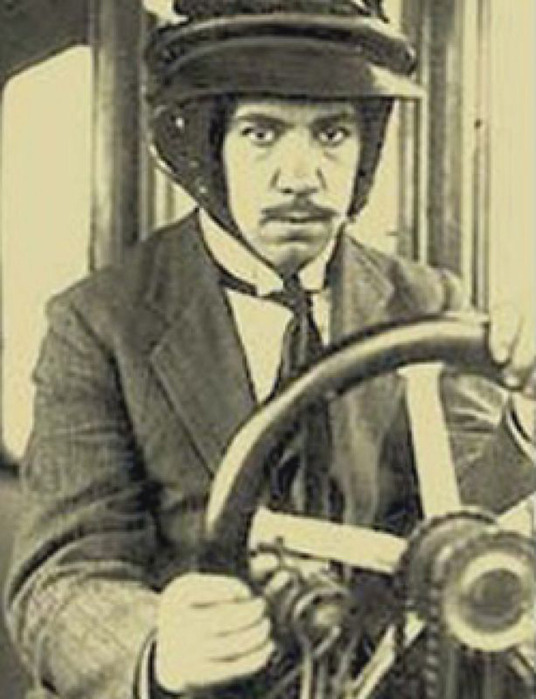
Y.M. Gakkel
Jacob Modestovich was born 12 May 1874, in the city of Irkutsk. His paternal grandfather was from Alsace and was a French citizen. From him the future Russian genius and got such an exotic name. During the invasion of Russia, the hordes of Napoleon, the regimental convoy (veterinary paramedic), Jacques Gakkel, was captured and sent to Eastern Siberia, where he remained forever, after accepting Russian citizenship after the war. His grandson - Modest Vasilyevich - was a talented military engineer who participated in the construction of the telegraph line from Vladivostok to Irkutsk. In memory of him, one of the stations of the Trans-Siberian Railway, Gakkelevka, was even named. In addition, Modest Vasilyevich erected a number of onshore facilities and lighthouses in Kronstadt and the Far East. At the age of thirty, a young man decided to start a family, taking as his wife a Yakut woman, Stefanida, who soon gave birth to his son Jacob.
In the family archives of Gakkeli, Yasha’s school photographs have been preserved, which clearly show that he was growing up to be a rather ugly boy. The engineer himself recalled afterwards: “I was narrow-eyed, low and also incredibly shy. In the gymnasium, the children did not see in me a friend of their usual childish pranks. Awarded the nickname "Mongol", I very soon learned to fight well and answer mockery with ridicule ... Being not accepted in any company, I began to spend a lot of time on books and soon became the first pupils. Most of all I was attracted to the mechanic. Today, I am grateful to my peers, having given me their childhood friendship, they gave me a lifetime work. ”
Passion for electrical engineering led to the direction of education of a young man who, having graduated from a real school at 1893, entered the Electrotechnical Institute located in St. Petersburg. Gakkel studied among the best students and showed great promise, but in the fourth year (at 1896) he got along with revolutionary-minded young people and engaged in distributing Marxist literature banned in the country among students. The police took him "on a pencil," and on one not very beautiful day, instead of defending his first engineering project, the young Yakov Modestovich was put under arrest on political charges ("for participating in revolutionary student organizations"). The oversight of the gendarmes gave Gakkel the opportunity to warn comrades who had time to search his apartment to free him from illegal literature. Nevertheless, in prison, the young man spent almost five months. Having considered his case, the management of the institute made a rather non-standard decision at that time. A slander student, contrary to the law, was not expelled, but only transferred to free listeners. In addition, the professorship of the institute was able to convince the prison commandant of the need to keep prisoner Gakkel access to technical literature. For six months, the institute courier brought books to him on Shpalernaya Street every week.
In May, 1897 Yakov Modestovich was released from prison and after some time brilliantly defended his graduation project. The young specialist wrote about what happened next: “I decided to celebrate my first scientific success with my friends with a traditional student party. I had almost half a course in my apartment. They drank champagne, sang in chorus. But at twelve the front door rang. The frightened maid called me to the front, and there the policeman gave me a prescription - to depart in three days to Siberia as an exile. For a period of five years! I tried not to show that news I was upset, and told me to bring a glass of champagne to the wreck: "Mr. Good, drink to the Russian engineer, whom fate has a great chance to serve the homeland where there are just not enough engineers!" The policeman was embarrassed, but supported the toast. Probably, the exile was in his memory for the first time happy that the authorities sent him away from the capital. ”
Soon the young Gakkel arrived at his place of exile - at Lena gold mines, located near the village of Bodaibo. It was a deaf region, a real Russian Klondike, whose population, in addition to local natives, were adventurers, convicts and gold prospectors. In 1896, on one of the mines located on the Nygre River, the second in the country (after the Zyryanovskaya hydroelectric station in Altai) and the first in Eastern Siberia hydroelectric station with a capacity of three hundred kilowatts, designed by Shukkert and Goltsen, gave the current. Jacob Modestovich, working as an electrical engineer, dealt with the problems of its year-round operation (including winter periods when the frost reached sixty degrees) and gaskets from the hydroelectric power station to the mines of high-voltage power lines. In exile, the young specialist met his fate - a member of a student revolt, a disgraced teacher Olga Glebovna, who was the daughter of the well-known writer Ouspensky. Subsequently, they had two children: a boy and a girl.
In Siberia, Gakkel worked up to 1903. When the term of the link ended, the couple moved to St. Petersburg. There, Yakov Modestovich was invited to take the place of an engineer at the technical office of Westinghouse, which was building the first electric trams. The young man agreed and together with another well-known Russian power engineer Heinrich Graftio worked in this society for the next six years, solving the problems of designing, building and launching Petersburg trams. At the same time, Jacob Modestovich taught a course of electrical traction at the Electrotechnical Institute. At the end of September 1907 in St. Petersburg, the grand opening of the tram traffic. The first tram was led by Heinrich Graftio himself, and Gakkel drove beside him. A year later, nine tram routes were already operating in the northern capital. For successfully completed work, as well as several of his own innovations, Jacob Modestovich received from the leadership of Westinghouse six thousand rubles of premium.
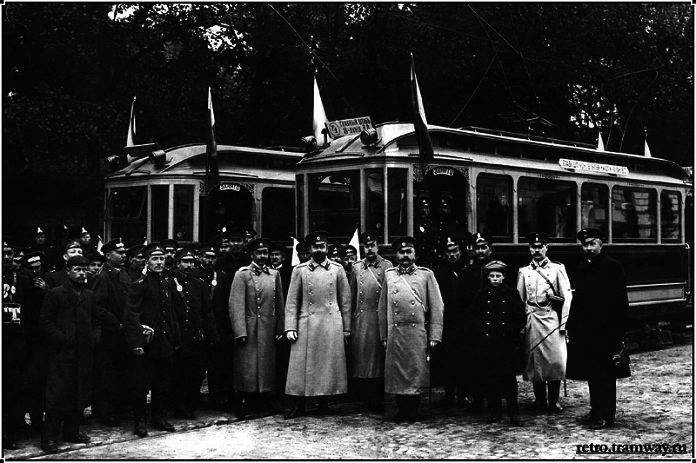
By that time, the design of the tram lines and dealing with the purchase of new cars abroad Gakkel began to seem routine. He wrote in his diary: “There was no such transport mechanical device, a device which I would not have studied and, if necessary, would not reproduce. Everything that walks on our land on wheels, I learned, and it already seemed to me boring and ordinary. ” It must be recalled here that the beginning of the twentieth century was marked by the energetic development of world and domestic aircraft manufacturing. Having studied everything that “walks on the ground”, Yakov Modestovich became interested in the new branch of mechanical engineering, saying: “Inspired by the works of American cowboys Wright and the Russian sailor Mozhaisky, I decided to create an airplane.”
In early 1909, together with the merchant Sergey Shchetinin, an engineer rented a carriage shed at the Kolomyazhsky Hippodrome, then turning it into aviation workshop. With his own hands, Yakov Modestovich assembled all the machines necessary for the work, only on the occasion of buying components and mainly using scrap metal warehouses - the enthusiast of the domestic aircraft industry had enough to repair the skills to qualify. By the way, on the materials Gakkel almost went bankrupt - a small salary of the tram network employee was not enough even for the most necessary. The prize received from Westinghouse was helped, which almost all went to the construction of the first aircraft.
In the spring of 1909, the Russian designer started the construction of his first aircraft. It seemed that at the same time it was most reasonable to start with the imitation of already flying constructions - the Bleriot, the Farmanov, the Wright, the Voisen. However, Jacob Modestovich took a different path. Already in his first device he tried to find more rational constructive solutions and effective aerodynamic forms. In particular, the bearing planes of the biplane, called “Gakkel-1”, were placed not on the same level, but shifted like steps of a ladder (with the lower wing carried forward). In terms of its design, the Gakkel-I was a biplane with reverse carrying out and a pair of propellers located between the wings and operated from the engine through a belt drive. The Antoinette motor with 25 horsepower, the designer put in front of the pilot, so that he could not push the pilot down on an unsuccessful landing, just as it did on the Farmans. After a quarter of a century (in 1937), the Hero of the Soviet Union, the famous pilot Mikhail Vodopyanov will say: “... It was Gakkel first who found the strength to abandon blind copying of foreign samples and built the aircraft of the original design ... Now nobody thinks otherwise a modern aircraft. The world unfairly forgotten by the engineer owes the appearance of the perfect kind of man-made bird. ”
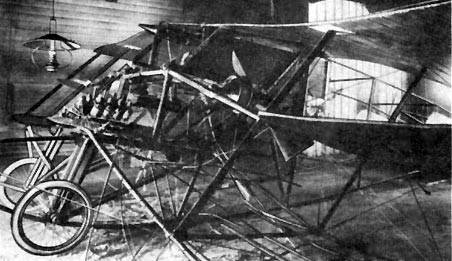 In July, 1909 after the creation of the draft design of the biplane Gakkel together with Schetinin organized the First Russian Aeronautical Partnership, based on mutual principles. The first plane began to be built in the workshop of Yakov Modestovich in November 1909, and in the middle of December, during the engine test, there was an outbreak of gasoline in the carburetor, and the almost ready Gakkel-I was badly burned. The designer did not restore it - by that time he had already discovered the weaknesses of his brainchild, the main of which was the low power of the motor compared to the take-off weight of the aircraft (400 kilogram), as well as the unreliability of the design of two propellers with a belt drive (hereinafter the inventor followed the usual single-screw scheme).
In July, 1909 after the creation of the draft design of the biplane Gakkel together with Schetinin organized the First Russian Aeronautical Partnership, based on mutual principles. The first plane began to be built in the workshop of Yakov Modestovich in November 1909, and in the middle of December, during the engine test, there was an outbreak of gasoline in the carburetor, and the almost ready Gakkel-I was badly burned. The designer did not restore it - by that time he had already discovered the weaknesses of his brainchild, the main of which was the low power of the motor compared to the take-off weight of the aircraft (400 kilogram), as well as the unreliability of the design of two propellers with a belt drive (hereinafter the inventor followed the usual single-screw scheme).In early January, 1910 first domestic aircraft building company cracked. Sergey Schetinin, the former managing director of the company, came to the conclusion that it was financially not profitable to work with Gakkel projects. On the offer of the partner to buy the drawings from Farman and to make the aircraft of his usual appearance, Jacob Modestovich answered with a categorical refusal and, having equipped his own workshop, began to develop his next plane, Gakkel II. This device was a brawless fuselage biplane. By the way, at that time the fuselage was considered characteristic only of a monoplane, and the Russian designer created the plan of the fuselage biplane completely independently (he became the second in the world after Frenchman Louis Breguet). The construction of the aircraft was completed in March of 1910, after student Gakkel’s assistant, Vladimir Bulgakov, brought from France a new Anzani engine in 35 horsepower. Unfortunately, the take-off during the tests could not be achieved. Gakkel wrote in his diary: "... The need to install a propeller in front of the motor was discovered, and therefore it was necessary to make changes to the design of the already completed second airplane, thus forming the number three airplane."
Gakkel III, which had a number of constructive innovations, was completed in May. The entire design of the aircraft was much more thoughtful, durable and rational. The first runs were made at the hippodrome, and then the device was transported to the Gatchina airfield. In early June, 1910 Yakov Modestovich brought General Nikolayev, the former Commissioner of the All-Russian Imperial Aeroclub, from St. Petersburg to Gatchina. Vladimir Bulgakov made for the guest a demonstration flight on an airplane. The archives of St. Petersburg preserved a document from the Imperial Aeroclub, which officially testified that in June 1910 "the first sports flight of an uniquely constructed airplane built by engineer Gakkel took place in Gatchina." For the first time, a seventeen-year-old boy who had previously flown a passenger on the Farman limited himself to a rise of several meters. Having flown about two hundred meters, the plane sat down smoothly. In the following months, the combination of pilot inexperience with unconfigured design (the Anzani engine did not pay off, which quickly overheated, and the S-shaped wing profile) did not give Gakkel-III the opportunity to show good results. Bulgakov was not able to win the award of the All-Russian Aeroclub, established at 1909 for the span of 230 meters in a straight line on an aircraft of Russian design. Despite this, the designer received a subsidy from the state for his work and finally ceased to be financially dependent on Sergey Shchetinin.
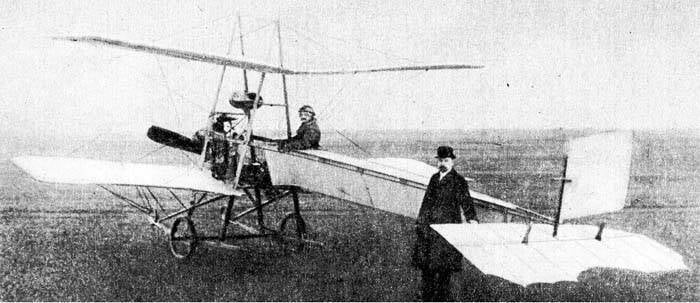
In August of the same year, Yakov Modestovich presented a new aircraft, the Gakkel-IV biplane. This one-rack biplane had a lot in common with the Gakkel-III, but it already had an Argus engine of one hundred horsepower. But, not having time to finish the device, the inventor became interested in a new idea - he decided to develop the first amphibian aircraft in the country. In December 1910 "Gakkel-V" was demonstrated in St. Petersburg at the first International aeronautical exhibition. The main force element of the original two-float monoplane became two hollow arched beams of wood, the displacement of which kept the device with two pilots afloat. The engine of the company "Oerlikon" with a capacity of fifty horsepower was located in front of the raised wing. To lower the center of gravity of the structure, the pilot's seats were placed by Jacob Modestovich near the water. Dual control allowed the pilots to conduct amphibians alternately. This aircraft was not tested, despite the fact that it was built two copies. Nevertheless, the Russian Technical Society in the spring of 1911 awarded the inventor a silver medal for the exhibition "for a unique design." Subsequently, experts noted that for a two-seater aircraft the engine power was clearly insufficient, and the low location of the unprotected pilots would inevitably lead to their cold baths during landings on the water.
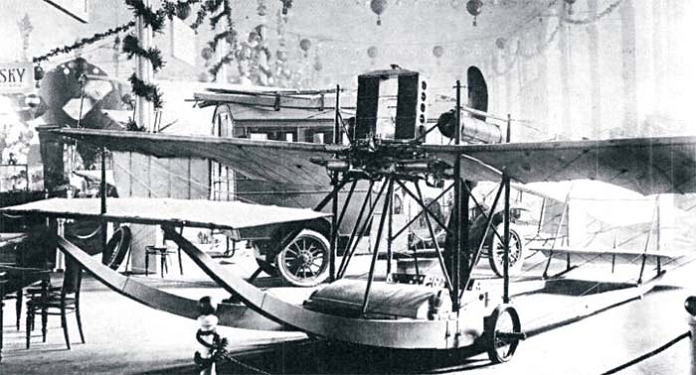
By the spring of 1911, Jacob Modestovich had finally finished work on Gakkel-IV. The main military engineering directorate decided to purchase this military-type "double plan", however, the pilot Volkov crashed during the flights in May and broke the car. During the restoration of the aircraft, Jacob Modestovich increased the wingspan by one span, as a result of which the Gakkel-VI was born - a two-post biplane in which the upper wing was larger than the lower one. It is curious that it was on this plane that the designer himself first flew into the sky. In June, the 1911, still a rather inexperienced flight engineer, during landing landed a biplane “Bristol” at the end of the runway from someone else’s hangar, breaking his spars and a number of ribs. The Gakkel-VI itself remained intact, only a small crack formed on the screw. It is curious that this case was the reason for the appearance of the first rules of landings and takeoffs at the airfield, on which previously there were not even wind direction indicators.
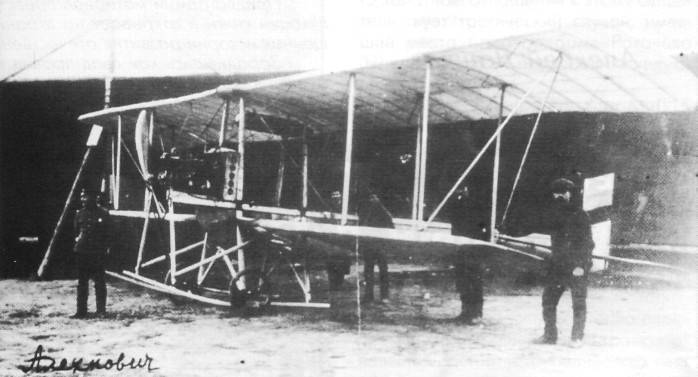
Jacob Modestovich himself, having replaced the propeller, resumed his flights the very next day. And soon the famous Russian pilot Gleb Alekhnovich, who had illegally studied at the Gatchina school, came to the inventor (the medical commission rejected the young man because of myopia). Having praised Gakkel's plane, he asked the designer to give him the opportunity to fly on it. It was a fateful meeting: a brilliant inventor and a talented aviator found each other. Since then, Gakkel’s planes in the hands of Gleb Vasilyevich have shown amazing flights in complexity and beauty. Alekhnovich quickly studied the Gakkel-VI and in the middle of July brilliantly completed the necessary program for obtaining a pilot-pilot diploma.
The very same designer in early September, 1911 presented the "Gakkel-VI" at the First Competition of domestic military aircraft. Only three aircraft participated in this competition - besides the brainchild of Yakov Modestovich, there was a biplane of the Petersburg Aviation Association and a monoplane of the Moscow Duks Aircraft Building Plant. Both rivals suffered accidents during the flights, and the Gakkel biplane itself was severely damaged during a hurricane - a squall wind blew up the tent in which the aircraft was located. Then the prudent inventor replaced it with his latest development, the new Gakkel-VII airplane. In October, 1911 Alekhnovich on the "Gakkele-VII" first flew from Gatchina to St. Petersburg. After landing at the Corpus aerodrome, where a special commission from the members of the Main Engineering Directorate was waiting for him, the pilot refueled with gasoline and then set off on the return journey. Having rested in Gatchina, Gleb Vasilyevich made a second flight to the city. As a result, Yakov Modestovich’s “only one of all presented” aircraft executed the entire complex program of the competition (including landing and taking off from the plowed field), but members of the Main Engineering Directorate, under this pretext, considered the competition failed and did not issue Gakkel prizes. Nevertheless, the plane "Gakkel-VII" was bought by the military department for eight thousand rubles.
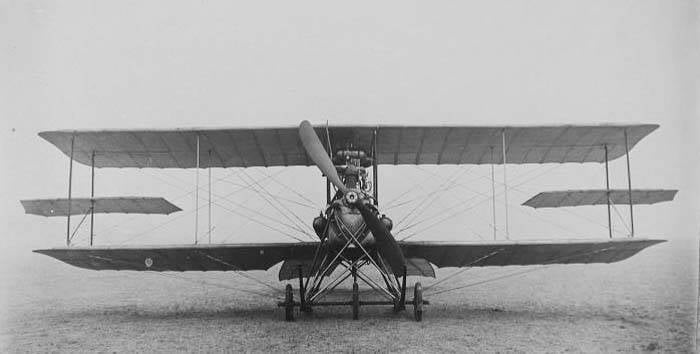
According to experts, the obedient to control, well-made constructively a real fuselage biplane “Gakkel-VII” could become an excellent training aircraft for military pilots, since the robust design of its chassis tolerated heavy blows during unsuccessful landings. However, the fate of this biplane was sad - it was overtaken to a military airfield and thrown there, because the school instructors, accustomed to the Farmans, did not want to master the device they did not know. Even a simple inspection of the aircraft was not carried out - the water from the radiator was not drained, and after the first frost the ice tore up the “shirt”. Another engine was not at hand, the “shirts” were not yet able to brew at that time, and the excellent aircraft, which no longer flew into the air, were scrapped.
Jacob Modestovich himself at this time was intensely preparing for the Second Military Competition, scheduled for the autumn of 1912. First, he built the Gakkel-VIII biplane, and then the country's first undersight monoplane, the Gakkel-IX, which he invented to create the best side view. The overall production performance of the Gakkel-VIII, equipped with an Argus engine of eighty horsepower, was much higher than that of the aircraft of the previous type. Gakkel-VIII, assembled in the designer’s workshop in the spring of 1912, was demonstrated at the Second International Aeronautical Exhibition, held in Moscow in March-April 1912, and received the Big Gold Medal from the Moscow Aeronautical Society. And in early May, competitions were held in Moscow, in which many famous pilots took part in the Farmans and LYAMs. During the competitions, Gleb Vasilyevich on the “Gakkele-VIII” set the Moscow record of flight duration (56 minutes and 56 seconds), as well as the Russian altitude record for biplanes - 1350 meters. According to the magazine “Aero and Automotive Life”, the competition convincingly proved that “domestic airplanes have already outstripped many of the best foreign ones.” By the way, during the competition, Alekhnovich also made night flights - while the landing strip was designated for him by spilled and burning gasoline pools. The same magazine noted: “Only on Gakkel’s airplane can one venture on such a thing, since his chassis has never broken during descent ...”. At the beginning of summer, several other competitions for altitude, figure flights and long-range flights took place at the Khodynka airfield, in which Gleb Vasilyevich won a number of prizes. And throughout the month of July, Alekhnovich spoke at Gakkele-VIII in Vyazma, Smolensk, Kursk and Gomel.
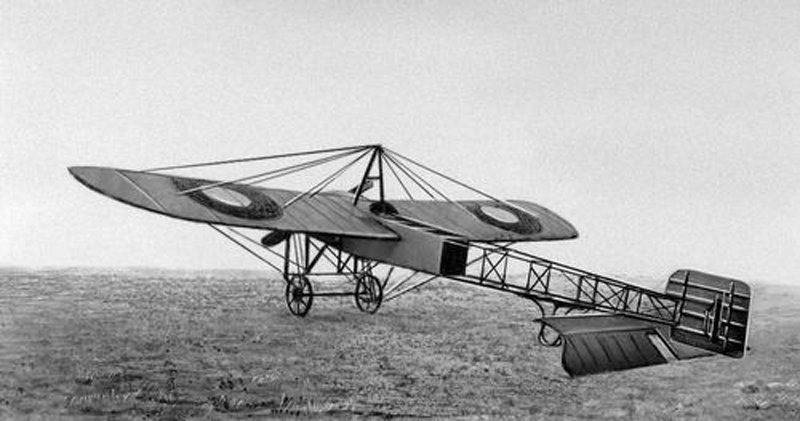
It seemed that both the designer’s aircraft (Gakkel-VIII and Gakkel-IX) were fully prepared for the Second Military Competition. They took part in it, but strange engine problems did not allow the aircraft to perform all the flights envisaged by the program. The reason for this was found only after many years. One of the mechanics of Gakkel was bribed by the workers of the competitor factory “Dux” and poured sulfuric acid into the shirts of the engines, which put them out of operation. On top of that, a strong fire occurred in the inventor's workshop in December 1912 “from an unexplained reason” that destroyed both planes. Gakkel, who did not receive any prizes at the competition, did not have the means not only to build new aircraft, but even to restore the workshop.
However, in April, the designer 1914 submitted for the tender announced by the Marine Technical Authority two new drawings of seaplanes. Negotiations began, but they led to nothing. Gakkel also drafted the creation of the joint stock company "Russian aircraft", wanting to interest any industrialist to finance the construction of their inventions. But such was not found. Another project of the bomber, which is a triplane with four engines located in the fuselage, which set in motion two propellers on the wings, the inventor sent to the military department. But even there they were not in a hurry to allocate money to the designer, since at the same time Ilya Muromets, the Sikorsky apparatus, was being tested. Not finding the means, Jacob Modestovich was forced to stop work in the field of aviation, although he never forgot about it. Already in Soviet times (in 1921), he drew a “perspective view” of a passenger triplane for thirty people, developed a model of a five-engine triplane, and made sketches of a “quadriplane”. The following year, Gakkel proposed to establish a society for the construction and use of aircraft on passenger air routes. Under this plan, he, with his usual thoroughness, created a draft design of a passenger three-engine biplane for fifteen places with one pulling and two pushing screws (“Gakkel-X”). But Glavduzdukhflotte did not accept this project - after the civil war, in an atmosphere of industrial disruption, it was not up to him. But the indefatigable designer did not stop there either. In 1923, he presented the draft training and sports apparatus "Gakkel-XI", and in 1924 - airplanes called "Fly". True, by that time Jacob Modestovich was already engaged in other areas of technology, and, as he himself wrote later, “did not have enough energy and time for aerial work.” In total, over the time span from 1909 to 1924, Gakkel designed more than a dozen aircraft of various purposes and types. Ten of them were lined up, and six were flying safely.
After a fire in the workshop that destroyed the last two built aircraft, the aircraft designer, who proposed the most promising model of the glider, had to return to the service of a railway engineer and take on the development of locomotives. At 1914, Gakkel was the technical director of the Rex plant. At this place, he, together with the engineer Kosobryuhov, designed and built the first in Russia light and powerful submarine batteries on domestic lead. Liberation from foreign dependence has become particularly important in connection with the onset of the First World War. And in 1918, the inventor was invited to the post of director of the Kiev tram.
The prototype of a modern diesel locomotive in Russia was developed as early as 1905 by colonel Odintsov and engineer Kuznetsov. Then there were many other projects, each of which intended to use internal combustion engines as a driving force. But a huge fleet of locomotives (albeit with a low efficiency), as well as large reserves of coal fuel, made it possible not to foul with the renewal of the traction train. The civil war and the revolution made their adjustments - the railway economy was in complete decline (more than sixty percent of locomotives were irretrievably lost). And then the Soviet government recalled the projects of Russian designers who worked in the field of diesel locomotive engineering. Among others, he offered his services to Gakkel, who created a power line diesel locomotive drawing at 1921.
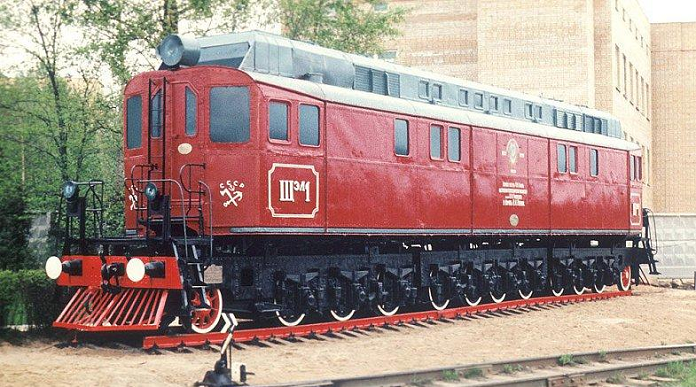
At the end of the same year, Lenin personally became interested in the works of the inventor and allocated funds from the republic’s budget to him. At the head of the diesel bureau of the Thermal Engineering Institute, Gakkel began building his own diesel locomotive, which became a unique creation by Soviet workers and engineers. Suffice it to say that it was assembled from parts of cars that were lying around without work. The main unit, the diesel engine, was removed from the Lebed submarine and repaired at the Baltic Shipyard. It also installed the body and the engine on the chassis, assembled on the "Red Putilovets." Participation in the construction of the locomotive and took the plant "Electric", where they were collected traction motors. Plant "Volta" handed generators, previously intended for the submarine "Yaz". Subsequently, Gakkel noted with a smile that only Swedish bearings and English diesel were foreign in his diesel locomotive, all other units were assembled from Russian materials by Russian engineers, technicians and workers.
By its appearance, the locomotive of Yakov Modestovich resembled not so much the locomotives of that time as railway cars. In the middle of the "car" was located the engine room, and at the ends there were exactly the same premises with mechanisms for control. By the way, two locomotive managed the mechanic-pilot (or driver) and the mechanic-mechanic who monitors the work of the engines. Outside, along the locomotive, there were large windows along a continuous line, and small windows above them, which made the whole locomotive not only look like a car, but also like a house with an attic or an attic. The ends were not flat, but triangular, and each facet had its own window, recalling the bay windows, popular in the architecture of the early nineteenth century. The cladding of the locomotive consisted of metal rectangular sheets, along the edges of which were located, resembling a large line, rows of rivets. Thus, the “push-pull” of Gakkel was one of the first creations of the human mind, when the work of cumbersome mechanisms was no longer shown off, and the streamlined, rapid outlines of the “case” hiding these very mechanisms were not yet in vogue.
1923 was supposed to finish work on the diesel locomotive at the end of September, but an unexpected event happened. During the flood, a number of diesel locomotive units, including traction motors, were flooded with water. However, Jacob Modestovich was not going to give up. With his own money, he managed to get hundreds of liters of rectified alcohol. Filling it in the cavity of electric motors, he managed to dry the windings. In early August, 1924 Shch-EL-1 - one of the first in the world, the most powerful for its time mainline diesel locomotive with power transmission - moved along the rail tracks of the Baltic plant. In November, it was handed over for further testing to workers of the Leningrad railway junction. The first flights of the diesel locomotive passed on the Oktyabrskaya road, and then systematic flights began on the Kursk-Moscow and Kharkov-Moscow routes. Farther trips were undertaken - from Grozny and Baku, on the seventh-eighth days, oil compositions were delivered to the capital. The weight of the composition at the same time was about 1300 tons of gross, and the cost of fuel for delivery were four times less than that of the locomotive.
Subsequently, both domestic and foreign experts noted many constructive solutions of Yakov Modestovich, who were ahead of their time and received further development, both here and abroad. At the All-Union Locomotive Competition, held at 1927, over fifty projects were presented (of which twenty-one were foreign specialists). The first and fourth places were taken by the work of Gakkel. The designer himself was not going to stop there. In the 1932-1936 years, at the Kaluga plant NKPS, according to his drawings, the country's first two-stroke diesel diesel engine of a three-horsepower structure was assembled in the country. And in 1934, by order of the government, Jacob Modestov built a steam tractor, implementing a valve steam engine, a welded boiler of unique design, and steam-free condensation without vacuum. Subsequently, Gakkel's valve steam unit was widely used on riverboats.
In 1936-1945, the inventor worked as a dean of the Mechanical Faculty of the Institute of Railway Engineers in Leningrad (now PGUPS) and at the same time a professor at the “Rolling Stock” department. During this time, he wrote many scientific papers (he received thirty-one patents for inventions), and at 1940 he was awarded the title of Honored Scientist and Technician for his fruitful engineering activities. In the same year, Jacob Modestovich developed the first gas-generating diesel locomotive, and at the very beginning of the war he designed mobile power trains for the front.
Gakkel never returned to aviation, although he continued to draw drawings of various airplanes. His children grew up and got an education. The daughter, Ekaterina Yakovlevna, followed the path of her father, becoming a major specialist in the field of locomotive automation. She, by the way, was one of the first women to receive the title of professor of technical department. The son of the inventor Yakov Yakovlevich was a prominent Soviet oceanographer and polar hydrologist. He took part in the expedition of Schmidt on the ship "Chelyuskin" and after the death of the icebreaker was removed from the ice by the pilot Mikhail Vodopyanov. In January, 1938, in a letter to Mikhail Vasilyevich, who saved his son, Professor Gakkel wrote: “Finishing my life, bringing to the fortieth anniversary of engineering, the results, I regret most of all that I left the aircraft industry ...”.
During the Great Patriotic War, Yakov Modestovich refused to leave besieged Leningrad. During the siege of the city, the health of the seventy-year-old inventor was severely undermined, and 12 December 1945 Gakkel died. The famous designer was buried on the Literary gangways. In 1988, a street in Primorsky District was named after him, and a memorial plaque was installed in his honor on the building of the Petersburg State University of Communications.
According to the materials of the sites http://rzd-expo.ru/ and http://www.avia-prad.ru.
Information